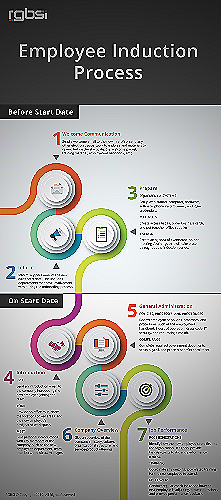What is Induction: Everything You Need to Know
In the world of business, the term “induction” is commonly used to describe the process of onboarding new employees. At its core, induction is all about ensuring that new recruits feel welcome and comfortable in their new roles, and that they are equipped with the knowledge and skills needed to perform their jobs effectively.
Induction is an essential part of the hiring process, and it can have a significant impact on the success of the new employee and the organization as a whole. A well-executed induction program can help to create a positive work culture, aid in the retention of employees, and increase overall job satisfaction.
What is Induction
Induction is the process by which new employees are introduced to their new workplace and the people they will be working with. It is a crucial component of any successful onboarding program, and it usually involves a combination of training, communication, and socialization.
During the induction process, new employees are typically given an introduction to the company’s history, culture, and values. They learn about their job responsibilities and the expectations that come with their role.
The Benefits of Induction
Induction is an essential part of the onboarding process, as it offers employees a thorough introduction into a new organisation, its culture, and goals. This process offers tremendous benefits to both the company and the employees.
Here are some of the benefits of induction:
Increased Employee Confidence
One of the most significant benefits of the induction process is that it helps new employees feel confident and comfortable in their roles. The new recruits can learn more about the company, its mission, and its culture, which increases their understanding of what is expected of them.
Having a solid understanding of what is expected of them, new recruits can perform their duties more effectively, leading to increased productivity and job satisfaction.
Better Performance and Lower Staff Turnover Rates
Effective induction programmes increase employee engagement and lead to better performance. Employees who are well-equipped with the knowledge and skills they need to do their job correctly will be more productive and motivated to contribute to the success of the company.
Additionally, a well-executed induction process reduces staff turnover rates by ensuring that new employees are integrated into their roles, are happy in their jobs, and feel supported by their companies, which leads to higher retention rates.
Improved Job Satisfaction and Morale
The induction process creates a positive first impression for new employees, leading to a more positive outlook on their jobs. Induction gives new employees a good understanding of the company culture and values, and it helps them understand their role within the organisation.
This leads to job satisfaction, higher morale and a better sense of loyalty to the company. A positive attitude is contagious, so the happier the workforce, the better the overall productivity and culture of the company.
How Induction Can Help Your Business
Induction helps ensure that new employees have the knowledge and skills they need to perform their jobs effectively, and it helps acclimate new employees to the company culture, goals and values. If new employees are left to learn on their own without proper guidance, they may become disengaged and feel unsupported.
On the other hand, a well-executed induction process leads to higher levels of performance, morale, job satisfaction, and an increased sense of loyalty to the company.
The Process of Induction
Induction is an essential process that welcomes and integrates new employees into their new workplace. The process of induction usually consists of a few steps such as pre-induction planning, welcome and orientation, training and development, performance management and feedback, and integration into the team.
Pre-induction Planning
Pre-induction planning includes preparing for the new employee’s arrival, which usually involves setting up the necessary systems, tools, and equipment, and getting the workplace ready for their arrival.
It is also important to create a plan that outlines the tasks, duties, and responsibilities of the new employee, and to share this with the relevant team members and managers.
Welcome and Orientation
The welcome and orientation step is an important aspect of induction, as it is the first impression and point of contact for the new employee. This step usually includes an introduction to the team and what the company does, as well as an overview of the employee’s position and expectations.
The new employee should be given a tour of the workplace to familiarize themselves with the facilities, and this is also an opportunity to introduce them to their colleagues.
Training and Development
The training and development step involves providing the new employee with the necessary tools, resources, and knowledge they need to perform their duties effectively.
This step can involve different types of training, such as job-specific training, software training, safety training, and other compliance training.
Performance Management and Feedback
The performance management and feedback step is important for the new employee to understand the expectations of their role and to receive constructive feedback on their performance.
Regular check-ins and performance reviews can help the new employee to identify areas for improvement, and to set goals for future development.
Integration into the Team
The final step of induction is the integration into the team, which involves fostering a positive workplace culture and building relationships with colleagues.
New employees should be encouraged to participate in social events and team-building activities, which can help them to feel more comfortable in their new workplace and improve their job satisfaction.

Common Challenges in Induction
Induction programs can be challenging for both the organization and new employees. Below are some common challenges that can arise during the induction process:
Timing and Length of the Induction Process
One of the challenges in induction is getting the timing and length of the process right. An induction that’s too short may leave new employees feeling unprepared and disoriented, while an induction that’s too long may lead to them feeling bored or overwhelmed.
The ideal length of an induction program can vary depending on the organization and the position, but it usually lasts between three days to several weeks.
Communication and Engagement
Effective communication is critical during the induction process. New employees need to be kept informed and engaged throughout the process so that they become fully integrated into the organization.
A lack of communication or engagement can lead to misunderstandings, misaligned expectations, and a high turnover rate.
Cultural and Language Barriers
Cultural and language differences can be a significant challenge during the induction process, especially in multinational organizations. A new employee may struggle to understand the organization’s culture or their new colleagues if they come from a different cultural and language background.
It’s important to include cultural awareness training and resources in induction programs to address this challenge.
Measuring the Success of Induction
Induction programs must be effective in integrating new employees into the organization, but measuring their success can be challenging. Measuring success can involve assessing employee retention rates, employee engagement, job satisfaction, and job performance.
Establishing clear benchmarks for success and regularly evaluating the induction process can help identify areas for improvement and ensure its continued effectiveness.
Examples of Successful Induction Programs
Tesla’s induction program includes engaging activities, group discussions, and presentations to help employees understand the company’s mission, values, and goals. They also offer a buddy system, where new hires are paired up with experienced colleagues to assist with onboarding and provide support.
Deloitte’s program includes a three-day induction event, followed by a six-month training plan. The induction event helps new hires understand the company’s culture and values, to build a sense of belonging.
The six-month training plan includes both online and offline learning activities to provide employees with the necessary skills and knowledge for their role.
Google’s program includes a “Noogler Orientation,” which is a mixture of classroom-style learning, interactive sessions, and opportunities for new hires to meet colleagues from different departments. New hires are given access to various resources, such as guides and training materials, to help them succeed in their role.
Google also offers a “buddy system” to new hires, similar to Tesla’s program.

